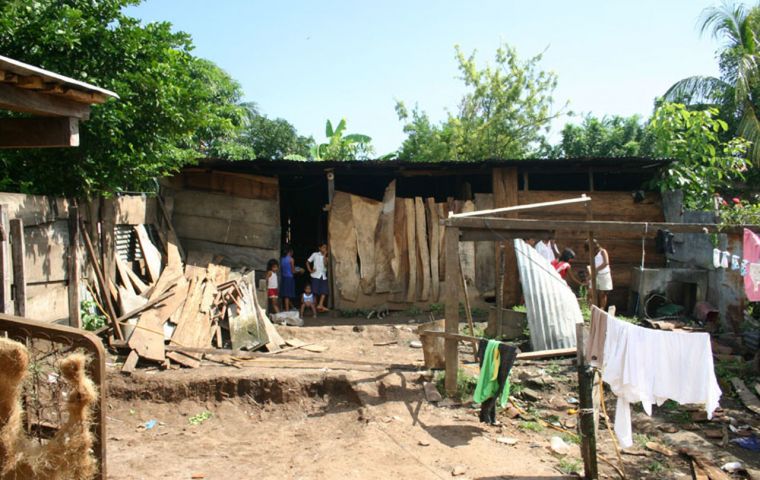MercoPress. South Atlantic News Agency
Extreme Poverty in Latin America rises to 86 Million because of pandemic, ECLAC report
 Extreme poverty would have been around 1.8 percentage points higher, and overall poverty would have been 2.9 percentage points higher on average in 7 countries.
Extreme poverty would have been around 1.8 percentage points higher, and overall poverty would have been 2.9 percentage points higher on average in 7 countries. In its annual report Social Panorama of Latin America, ECLAC estimates that the number of people living in extreme poverty rose by around 5 million between 2020 and 2021. The United Nations organization calls for moving towards universal, comprehensive, sustainable, and resilient social protection systems.
The health crisis is still ongoing, and Latin America and the Caribbean is the world’s most vulnerable region in this pandemic. Thus, as a result of the prolonged health and social crisis stemming from the COVID-19 pandemic, the extreme poverty rate in Latin America has risen from 13.1% of the population in 2020 to 13.8% in 2021 – representing a 27-year setback – while the overall poverty rate is estimated to have fallen slightly, from 33.0% to 32.1% of the population. This means that the number of people living in extreme poverty went from 81 million to 86 million, while the total number of people in situations of poverty declined slightly from 204 million to 201 million, the Economic Commission for Latin America and the Caribbean (ECLAC) report indicated.
“Despite the economic recovery experienced in 2021, the estimated relative and absolute levels of poverty and extreme poverty have remained above those recorded in 2019, which reflects the ongoing social crisis. The crisis has also exposed the vulnerability in which a fair share of people in the middle income strata lives, characterized by low levels of contributions to contributory social protection and very low coverage of non-contributory social protection,” states the annual report Social Panorama of Latin America 2021, launched at a virtual press conference by ECLAC’s Executive Secretary, Alicia Bárcena.
According to this document, the region experienced a major setback in fighting poverty in 2020 due to the pandemic. Both poverty and extreme poverty increased for a sixth consecutive year. In 2020, extreme poverty reached the levels seen 27 years before, while the overall poverty rate was at levels akin to those at the end of the 2000s.
In the study, ECLAC indicates that in 2020 the proportion of women who did not receive any income of their own increased, and poverty gaps persisted in rural areas and among indigenous peoples and children. In addition, an examination of various indices, including the Gini coefficient, verified an increase in inequality.
According to the United Nations organization, poverty would have been greater in 2020 if the region’s countries had not implemented measures such as emergency cash transfers. Extreme poverty would have been around 1.8 percentage points higher, and overall poverty would have been 2.9 percentage points higher on average in 7 countries.
Nonetheless, the Social Panorama 2021 notes that whereas in the last 10 months of 2020, the emergency transfers announced by countries to mitigate the crisis’s effects amounted to US$ 89.7 billion dollars, in the first 10 months of 2021, announced spending on these measures was half that: US$ 45.3 billion dollars.
“The economic ‘recovery’ of 2021 has not been enough to mitigate the pandemic’s deep social and labor effects, which are closely linked to income and gender inequality, to poverty, to informality and to the vulnerability in which the population lives,” stated Alicia Bárcena, who called for maintaining emergency cash transfers in 2022 or until the health crisis is brought under control.
In the study, ECLAC stresses that the economic recovery will not be sustainable unless the health crisis is brought under control, and it warns that Latin America and the Caribbean is the region of the world that is most vulnerable to COVID-19.
This region has the highest number of deaths due to COVID-19 reported worldwide (1,562,845 as of December 31, 2021), a figure that will keep rising as long as the pandemic continues. This represents 28.8% of all the COVID-19-related deaths reported in the world, despite the fact that the region’s population accounts for just 8.4% of the global population.
As of January 26, 2022, 62,3% of Latin America and the Caribbean’s population (around 408 million people) had been fully vaccinated; as a result, ECLAC called for intensifying efforts so that by mid-2022 all the region’s countries will have fully vaccinated 70% of their population.




Top Comments
Disclaimer & comment rulesCommenting for this story is now closed.
If you have a Facebook account, become a fan and comment on our Facebook Page!